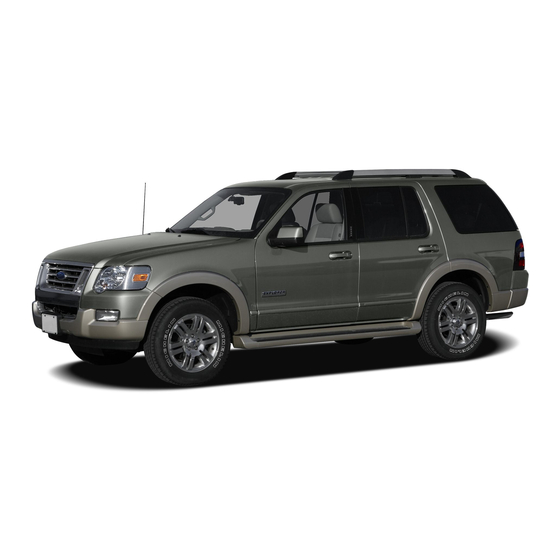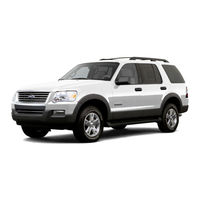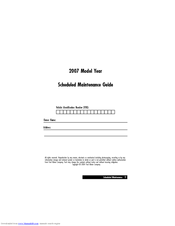
Ford 2007 Explorer Manuals
Manuals and User Guides for Ford 2007 Explorer. We have 4 Ford 2007 Explorer manuals available for free PDF download: Owner's Manual, Maintenance Manual, Quick Reference Manual
Ford 2007 Explorer Owner's Manual (369 pages)
Ford 2007 Ford Explorer (exp) Owner's Guide
Brand: Ford
|
Category: Automobile
|
Size: 4 MB
Table of Contents
-
-
-
-
Safety Belt15
-
O/D off16
-
Advancetrac17
-
Low Fuel17
-
Gauges18
-
-
-
-
Quick Start45
-
Operation57
-
Angle Mode59
-
Aspect Ratio59
-
Menu Mode59
-
Language60
-
Subtitles60
-
Audio Cds61
-
Slow Play64
-
-
-
Lights
79-
High Beams80
-
-
-
Window Lock95
-
Moon Roof102
-
Programming104
-
Info Menu107
-
Setup Menu108
-
System Check109
-
Autolamp111
-
Autolock111
-
Autounlock112
-
Compass Display113
-
System Warnings115
-
Reset118
-
Blank Display121
-
Fuel Used121
-
Running Boards125
-
Cargo Cover134
-
Rear Liftgate135
-
Luggage Rack136
-
-
Keys137
-
Power Door Locks137
-
-
-
Automatic Arming151
-
Replacement Keys151
-
-
-
Heated Seats158
-
Rear Seats158
-
-
Belt-Minder176
-
One Time Disable179
-
-
Tires213
-
Tire Inflation214
-
Tire Care216
-
Damage217
-
Tire Wear217
-
Safety Practices219
-
Highway Hazards220
-
Tire Rotation220
-
-
Payload232
-
Cargo Weight233
-
Gvwr234
-
Trailer Towing238
-
Hitches240
-
Preparing to Tow240
-
Safety Chains241
-
Trailer Brakes241
-
Trailer Lamps241
-
Driving
245-
Starting245
-
Brakes249
-
-
Steering255
-
Audible Warnings265
-
Parking270
-
4WD Systems271
-
Sand271
-
Mud and Water271
-
-
-
Fuses and Relays279
-
Fuses281
-
Jump Starting297
-
Wrecker Towing302
-
Cleaning
312-
Exterior Chrome312
-
Waxing313
-
Paint Chips313
-
4.6L V8 Engine315
-
Interior317
-
Leather Seats318
-
Underbody318
-
-
Opening the Hood321
-
Engine Oil325
-
Battery330
-
Engine Coolant332
-
Fuel Information338
-
Fuel Filler Cap341
-
Cleaner Air343
-
Fuel Quality343
-
Filling the Tank344
-
Habits345
-
Conditions346
-
Maintenance346
-
Brake Fluid350
-
Air Filter352
-
Engine Data358
-
Accessories
361 -
Index
363
Advertisement
Ford 2007 Explorer Owner's Manual (782 pages)
Brand: Ford
|
Category: Automobile
|
Size: 6 MB
Table of Contents
-
Español
1-
-
Espejos103
-
Toldo Corredizo109
-
-
-
Asientos167
-
Bolsas de Aire209
-
-
Manejo
270 -
Limpieza
342 -
-
Aceite del Motor356
-
Batería361
-
Datos del Motor394
-
Accesorios
397 -
Índice
399
-
English
407-
Introduction
410 -
-
Gauges424
-
Climate Controls
478 -
Lights
486 -
Driver Controls
496-
Power Windows 95501
-
Mirrors503
-
Speed Control505
-
Moon Roof509
-
Message Center517
-
-
-
Driving
653 -
-
Fuses and Relays688
-
Jump Starting704
-
Wrecker Towing710
-
Cleaning
720 -
-
Engine Oil733
-
Battery738
-
Engine Coolant740
-
Air Filter(S)760
-
Engine Data766
-
-
Accessories
769 -
Index
771
-
Ford 2007 Explorer Maintenance Manual (48 pages)
Scheduled Maintenance Guide
Brand: Ford
|
Category: Automobile
|
Size: 0 MB
Table of Contents
-
Exceptions46
Advertisement
Ford 2007 Explorer Quick Reference Manual (2 pages)
Ford Motor Company Automobile Quick Reference Guide
Brand: Ford
|
Category: Automobile
|
Size: 3 MB
Table of Contents
-
Seating1



